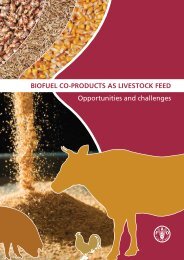Distillers Grains Feeding Recommendations. - Distillers Grains By ...
Distillers Grains Feeding Recommendations. - Distillers Grains By ...
Distillers Grains Feeding Recommendations. - Distillers Grains By ...
You also want an ePaper? Increase the reach of your titles
YUMPU automatically turns print PDFs into web optimized ePapers that Google loves.
that diets containing 31.2% wet corn DG versus a control diet (corn-soybean meal-based)resulted in a 13.6% increase in efficiency of energy-corrected milk production. The foragecomponent of these diets contained ~63% corn silage and 37% alfalfa hay and resulted in a totaldietary CP content of 21% and 22% elevation of serum urea levels. So, long-term considerationswhen feeding high levels of corn DG need to be: 1) proper ratio of forage sources to reducedietary CP, and 2) supplemental sources of lysine if corn silage comprises the majority of theforage. It appears that total CP, and possibly lipid, in the diet will set upper limits on the amountof DG that can be incorporated into the ration, but 20 to 30% is feasible if the ration is properlyformulated. Logical possibilities exist to combine DG and CGF to capitalize on the uniqueattributes of both coproducts (digestible NDF from CGF and RUP plus lipid from DG) to createproducts that would allow higher levels of inclusion in the diet and increase efficiency of milkproduction. In addition, there is evidence that the lipid in corn DG is effective at increasing theunsaturated to saturated fatty acid ratio in milk fat (Schingoethe et al., 1999).Two major questions concerning use of DG by dairy cows are: 1) is there a difference betweenwet and dry DG, and 2) does source of grain for the fermentation impact the nutritive value ofthe DG. One study (Al-Suwaiegh et al., 1999) has compared wet versus dry DG from thefermentation of either 100% corn or 100% sorghum. All the diets contained 50% of a 1:1mixture of alfalfa and corn silages and 15% DG. Chemical composition of the corn and sorghumDG were similar. Efficiency of FCM production was similar for cows fed either corn orsorghum DG in the wet or dry form (Table 8). Since efficiency was the same, whether wet ordry, the form of the DG is primarily a function of what works best for the farm given the feedstorage and handling capabilities. The production of 4% FCM tended to be reduced when cowswere fed DG from sorghum versus corn. The impact of grain source on the quality of DG and itseffect on long-term milk production is unknown. Because we know that wet and dry DG aresimilar, a study needs to be conducted that compares either wet or dry DG fed continuouslyduring early lactation.<strong>Feeding</strong> DG and CGF to Dairy Cows: Bottom LineUnquestionably, DG and CGF are excellent sources of digestible NDF, RUP, and lipid for dairycattle diets. Particularly for CGF, much more (at least 2x) can be incorporated into diets thanhas been previously recommended. We need to consider the nutrient profile of these coproducts,and supplement to correct any nutrient deficiencies, either to the diet or by creatively combiningvarious milling coproducts. In addition, we need to manipulate the physical as well as thechemical properties of the forage component of the diet to maximize the use of these coproducts.There is tremendous potential to combine corn milling coproducts that will allow maximalreplacement of forage and concentrate. This approach will likely become more important asmore ethanol plants are built over the next several years. The traditional paradigm in feedingdairy cattle has been to maximize the amount of forage in the diet which necessitates anexquisite focus on forage quality. However, when high quality forage is expensive or in limitedsupply, or in areas where coproducts are abundant, the paradigm needs to shift to maximizinguse of the byproduct and ensuring that the forage meets the minimal requirements for physicallyeffective NDF. Both DG and CGF products should be effective at providing a consistent quality,highly digestible diet for lactating dairy cows.
















